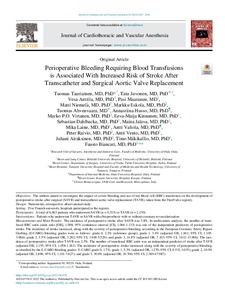Perioperative Bleeding Requiring Blood Transfusions is Associated With Increased Risk of Stroke After Transcatheter and Surgical Aortic Valve Replacement
Tauriainen Tuomas; Juvonen Tatu; Anttila Vesa; Maaranen Pasi; Niemelä Matti; Eskola Markku; Ahvenvaara Tuomas; Husso Annastiina; Virtanen Marko PO; Kinnunen Eeva-Maija; Dahlbacka Sebastian; Jalava Maina; Laine Mika; Valtola Antti; Raivio Peter; Vento Antti; Airaksinen Juhani; Mäkikallio Timo; Biancari Fausto
https://urn.fi/URN:NBN:fi-fe2022081154369
Tiivistelmä
OBJECTIVES
The authors aimed to investigate the impact of severe bleeding and use of red blood cell (RBC) transfusion on the development of postoperative stroke after surgical (SAVR) and transcatheter aortic valve replacement (TAVR), taken from the FinnValve registry.
DESIGN
Nationwide, retrospective observational study.
SETTING
Five Finnish university hospitals participated in the registry.
PARTICIPANTS
A total of 6,463 patients who underwent SAVR (n = 4,333) or TAVR (n = 2,130).
INTERVENTIONS
Patients who underwent TAVR or SAVR with a bioprosthesis with or without coronary revascularization.
MEASUREMENTS AND MAIN RESULTS
The incidence of postoperative stroke after SAVR was 3.8%. In multivariate analysis, the number of transfused RBC units (odds ratio [OR], 1.098; 95% confidence interval [CI], 1.064-1.133) was one of the independent predictors of postoperative stroke. The incidence of stroke increased, along with the severity of perioperative bleeding, according to the European Coronary Artery Bypass Grafting (E-CABG) bleeding grades were as follows: grade 0, 2.2% (reference group); grade 1, 3.4% (adjusted OR, 1.841; 95% CI, 1.105-3.066); grade 2, 5.5% (adjusted OR, 3.282; 95% CI, 1.948-5.529); and grade 3, 14.8% (adjusted OR, 7.103; 95% CI, 3.612-13.966). The incidence of postoperative stroke after TAVR was 2.5%. The number of transfused RBC units was an independent predictor of stroke after TAVR (adjusted OR, 1.155; 95% CI, 1.058-1.261). The incidence of postoperative stroke increased, along with the severity of perioperative bleeding, as stratified by the E-CABG bleeding grades: E-CABG grade 0, 1.7%; grade 1, 5.3% (adjusted OR, 1.270; 95% CI, 0.532-3.035); grade 2, 10.0% (adjusted OR, 2.898; 95% CI, 1.101-7.627); and grade 3, 30.0% (adjusted OR, 10.706; 95% CI, 2.389-47.987).
CONCLUSIONS
Perioperative bleeding requiring RBC transfusion and/or reoperation for intrathoracic bleeding is associated with an increased risk of postoperative stroke after SAVR and TAVR. Patient blood management and meticulous preprocedural planning and operative technique aiming to avoid significant perioperative bleeding may reduce the risk of cerebrovascular complications.
Kokoelmat
- Rinnakkaistallenteet [27094]
